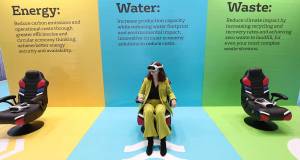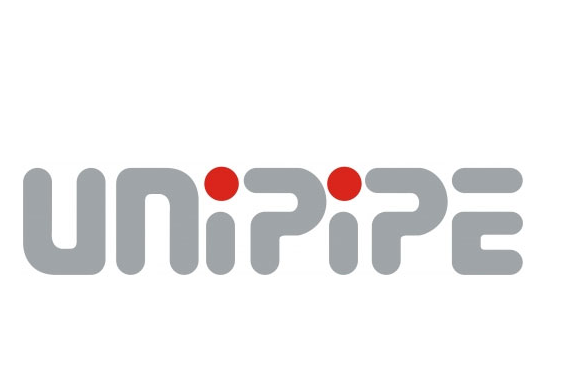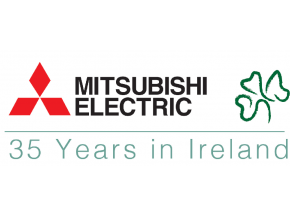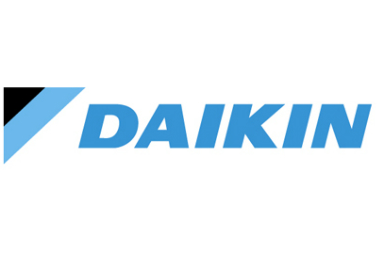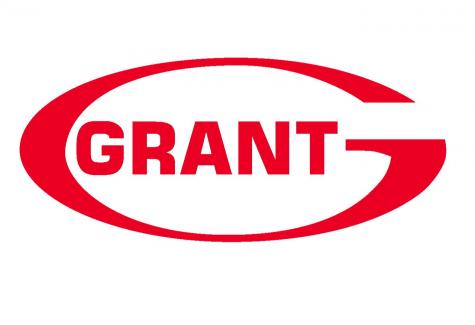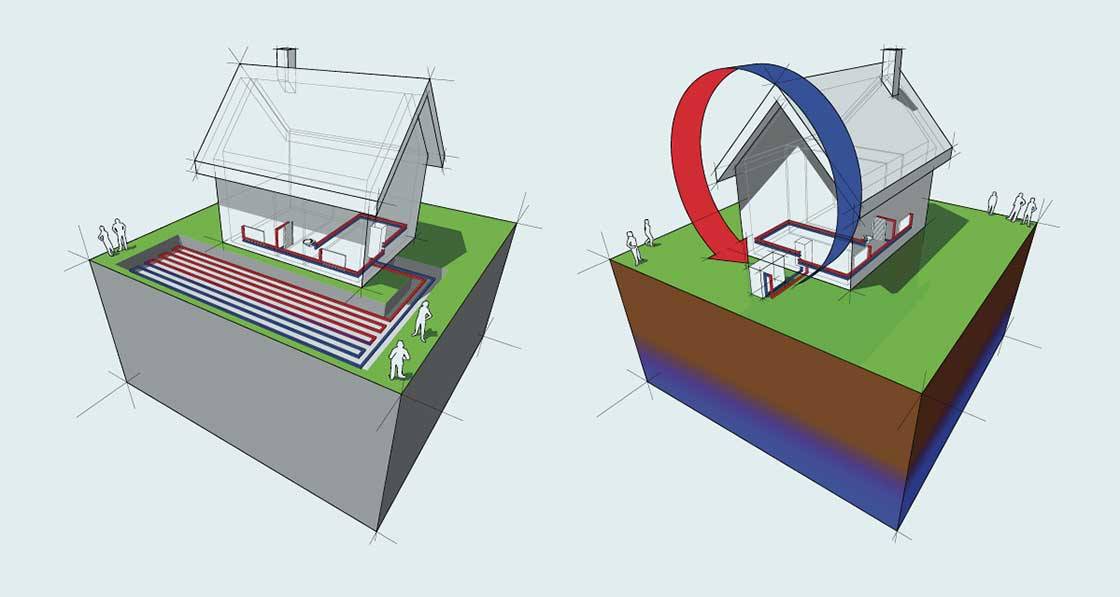
- Feature
- Posted
Heat pump grants - what you need to know
As of 16 April, owners of pre 2011 Irish homes are now eligible for generous grants to retrofit heat pumps, and in so doing help to create comfortable, economical, low carbon homes. But what’s the thinking behind the scheme, and what results can participating homeowners expect?
This article was originally published in issue 25 of Passive House Plus magazine. Want immediate access to all back issues and exclusive extra content? Click here to subscribe for as little as €10, or click here to receive the next issue free of charge
Following an announcement by climate change & environment minister Denis Naughten, the Sustainable Energy Authority of Ireland has introduced a number of changes to the Better Energy Homes grant scheme for retrofits including increased grants for external wall insulation and heating controls, and two measures which signal a dramatic change in emphasis: the elimination of grants for fossil fuelled boilers and the introduction of heat pump grants from 16 April.
The Bartholomew Barn, a new £1.2m school building at King’s Hawford, is a multi-purpose sports and drama hall that will be used for sports, assemblies, drama, music and dance.
In a detailed statement to Passive House Plus, SEAI said that the changes reflect an objective to drive building fabric upgrades and stimulate an accelerated decarbonisation of heat supply. The decision to introduce heat pump grants was “primarily to accelerate the move away from fossil fuels towards renewable forms of heating. Hence the discontinuation of the grant for oil/gas boilers with controls and the introduction of a single higher grant for heating controls only.” SEAI said that the addition of a heat pump grant arises from the ongoing review of the programme and the objective of supporting more renewable heating options, on top of the existing supports for solar thermal.
“Heat pumps are very efficient electrical devices which convert energy from the outside of your home into useful heat inside your home, in the same way a fridge extracts heat from its inside,” SEAI said. “They even work in Ireland’s cold winters. This extracted heat can then be used to heat your home and hot water. The beauty of a heat pump is that every unit of electricity used in the process yields about four units of heat. In well insulated houses they are very economical to run and are an extremely efficient alternative to fossil fuel-based heating systems.”
There are a number of different types of heat pumps – including air-to-water, groundto- water, exhaust air-to-water, water-to-water and air-to-air heat pumps, which have varying characteristics and applications. All of these forms of heat pumps are eligible for the new grants, which comes at a flat rate of €3,500 for all types with the exception of air-to-air, which receive a far lower grant of €600. Homes built from 2011 onwards are ineligible.
Air-to-air systems are seldom used in homes in Ireland. They’re essentially air conditioning systems – which can efficiently heat or cool the air in a building but don’t heat water – and the low grant may be a reflection of both the lack of demand and their relatively low capital cost. Domestic hot water heat pumps – which are designed to generate hot water only – are not eligible.
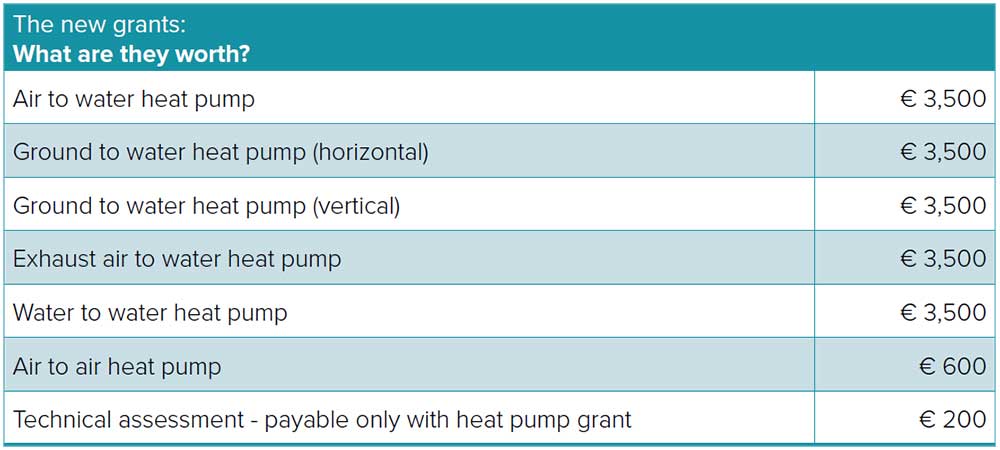
There is an argument that a flat grant for all other heat pumps is something of a blunt instrument, and doesn’t reflect the fact that different heat pumps will achieve different efficiencies – depending on anything from the temperatures they’re designed to operate at, to the temperature of the heat source they’re tapping into. For instance, ground source heat pumps tend to have higher efficiencies than air source units during the heating season due to the relative stability of ground temperatures below certain depths, though air source units – which involve much lower capital costs – have closed the gap in recent years as manufacturers have refined their design, and there is evidence to indicate that space heating demand in many Irish buildings may be peaking in Ireland’s frequently relatively mild but windy weather, as the guide to air source heat pumps in Issue 24 of Passive House Plus discussed.
Investments in high tech sustainable technology ideally shouldn’t happen till cost-effective fabric energy efficiency measures have first been delivered, and SEAI’s changes to the grant system have been designed to reflect that.
“For optimum efficiency, heat pumps should only be installed in well-insulated homes,” SEAI said. “If the home is not properly insulated it is highly likely that the home will not be heated properly and the homeowner’s electricity bills will be higher than expected.”
To address this, SEAI has introduced a process that it claims will ensure that the homes are actually suitable for a heat pump based on a fabric first approach. The minimum requirement will be based on the total heat loss for the dwelling, which includes the fabric and ventilation heat loss. The Heat Loss Indicator, or HLI, is the total heat loss per square metre of dwelling floor area. This is calculated using SEAI’s Deap software, which is used to determine Building Energy Ratings for homes, and to determine compliance with Part L of the building regulations for new homes. The HLI is defined as follows:
HLI= (Fabric Heat Loss+Ventilation Heat Loss )/(Floor area of dwelling) [W/(K∙ m^2 )]
The HLI will be used to determine the energy performance of the dwelling for the purpose of Better Energy Homes grants for heat pump systems and must be no more than 2 W/Km2, which industry sources have indicated will typically translate to roughly a C1 BER.
Central to determining this calculation will be the role of an independent SEAI-registered technical advisor, who will carry out the required technical assessment to determine the suitability of a home for a heat pump system.
How can you improve the Heat Loss Indicator of a poorly performing home?
The technical assessment report will set out the specifics for each individual home. SEAI said it is likely to include recommendations to improve the insulation of the walls, attic and possibly floors. It may also require the installation of high performance double or triple glazed windows and doors. “Doing this will generally make a home more airtight which is good but which will necessitate a ventilation strategy for occupant health and to protect against condensation effects,” said SEAI. “That might sound like a contradiction, but ventilation is extremely important.”
SEAI already offers grants for three types of wall insulation (external wall insulation, internal dry lining and cavity wall insulation) as well as attic insulation, for new homes built before 2006.
Who is the technical advisor and what do they do?
An independent SEAI-registered technical advisor will be an engineer, architect, quantity surveyor or relevant construction professional who is also a registered domestic BER assessor and who has attended an SEAI technical advisor workshop.
The technical advisor will calculate the Heat Loss Indicator and thus the home’s suitability for a heat pump. This information may already be available where a home has a current valid BER. If not, the advisor will publish a new BER, as up-to date BERs are prerequisites for the heat pump grant. The technical advisor will produce a technical assessment which will indicate that either the home is already heat pump ready or, if not, what upgrades are necessary to make it so. At the time of applying for a heat pump grant, the homeowner is required to upload the technical assessment document attesting to the home’s eligibility or what needs to be done to achieve eligibility. Where upgrade works are necessary then the technical assessment document can be used by the homeowner to get quotes from contractors for these works.
Homeowners who successfully proceed with a grant-aided heat pump system installation will receive a €200 grant towards the cost of the technical advisor.
“The introduction of the independent SEAI registered technical assessor role is a further step to help professionalise residential retrofitting,” said SEAI, adding that the authority will soon publish a list of independent SEAI-registered technical advisors on its website. To be eligible for registration candidates must be a registered domestic BER assessor and have a FETAC Level 7 in engineering, architecture, quantity surveying, construction or equivalent. Candidates must demonstrate adequate experience and full membership of relevant professional associations.
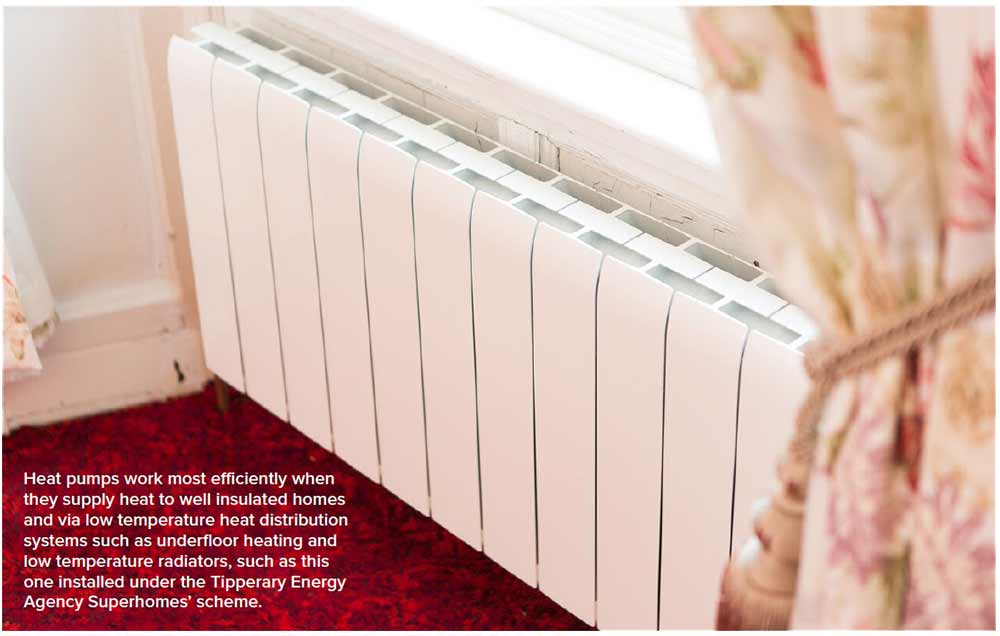
What are the requirements to register as a heat pump installer?
SEAI told Passive House Plus that eligibility requirements for heat pump installers would include a FETAC Level 6 plumbing certificate with a minor in electrics, a certificate of competency from the manufacturers of the appliances they intend installing, and – from 1 January 2019 – FETAC Level 6 in heat pump installation or registration on SEAI’s register of renewables installers. As Passive House Plus went to press, Heat Pump Association of Ireland director Paul O’Donnell said that SEAI had confirmed it would allow for equivalent proof or grandfather rights to non-FETAC 6 paper holders.
As with all other registered contractors under the programme, heat pump installers will also be required to abide by the Better Energy Homes terms and conditions, including requirements to be tax compliant and properly insured. They must complete the installation in full accordance with the code of practice. They will also be subject to SEAI’s quality assurance and disciplinary procedure.
The heat pump section in the code of practice is currently being updated.
Are there any differences to other Better Energy Homes grant eligibility terms?
Aside from the requirement for the technical assessment report described above only one eligibility term is different for the heat pump system grant. The year of construction and first occupation for the home in question must be before 2011. This eligibility criteria has also been extended to the solar thermal grant. “Homes built after this date were subject to building regulations which mandated a minimum level of renewables,” said SEAI. (Renewable energy became mandatory for new homes in TGD L 2008, also including all new homes where planning applications had been lodged before 1 July 2008, unless the structure of the external walls was substantially completed by July 2009.)
For insulation grants and heating control grants under the Better Energy Homes programme, the requirement remains unchanged where construction and first occupation must be before 2006.
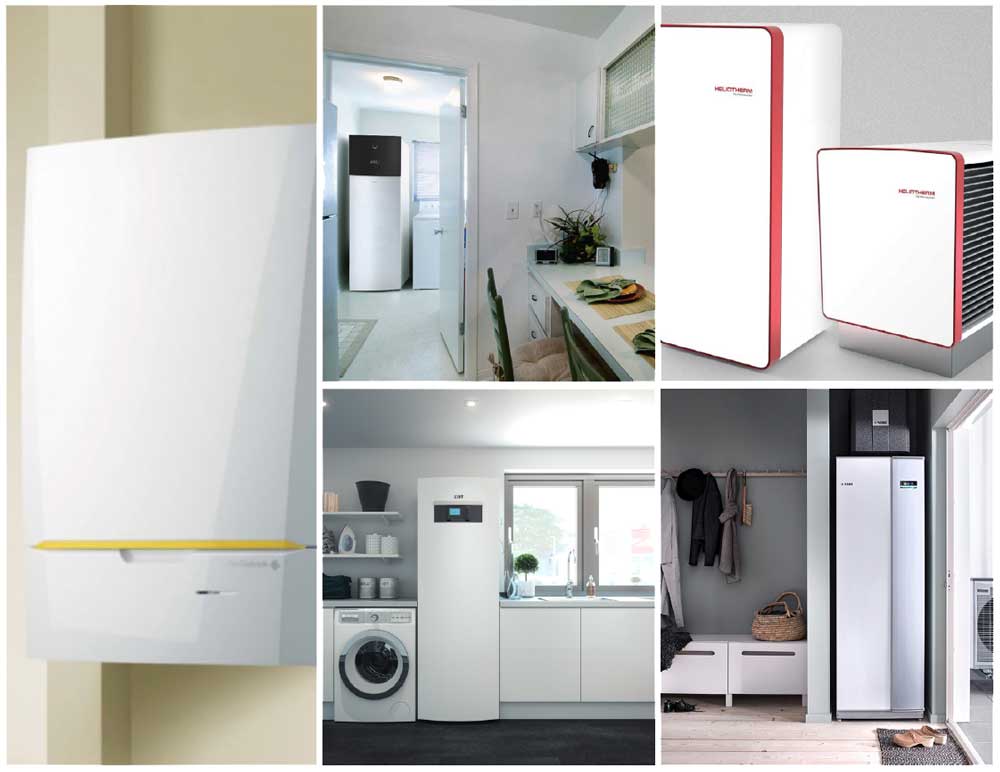
The indoor units for modern heat pumps often now resemble stylish fridges in their appearance. Seen here, clockwise from left, are systems from De Dietrich, Daikin, Heliotherm, Nibe and IVT.
Response
The Heat Pump Association of Ireland (HPAI) – the independent body set up to represent the heat pump industry – welcomed the news, while noting that the scheme was announced sooner than the industry expected.
The sector has been booming in recent years. As reported in issue 24 of Passive House Plus, data from SEAI’s National BER Research Tool indicates that 37% of all new homes built in 2017 featured heat pumps – a figure which may be conservative, given the signs that thousands of self-builders may not be obtaining BERs before occupying homes, and the fact that heat pumps are the dominant heating system in self-build houses, with over 67% of detached homes where the owner had obtained a BER prior to occupancy opting for a heat pump. “While this message is fantastic for the heat pump industry we think the announcement of grants for retrofitting heat pumps will account for quite a small impact on sales,” said HPAI director Paul O’Donnell.
“Of course the HPAI welcome any positive encouragement of the use of heat pump technology – that it’s not just for new housing, that the grants for oil and gas are gone, and it’s a positive message in terms of public awareness of heat pumps.”
Passive House Plus also spoke to O’Donnell’s fellow HPAI director Brian Cooley and chairman Calin Tasnadi, who welcomed the announcement, but warned that the introduction of many new suppliers and installers means that care would be required to ensure the right quality of product arriving into the market and of heat pump installation, so that end users have a positive experience of the technology.
“Grant aid is always seen as benefit and will give a boost to the heat pump industry on the whole, mainly due to the government’s stamp of approval to say ‘this is the future – replacing fossil fuel with a renewable source like heat pumps is the way forward,’” said Brian Cooley.
The HPAI said that the criteria surrounding the persons deemed qualified to fit a heat pump in order to receive a grant would risk ruling out many of the best and most experienced installers if SEAI had decided to require FETAC qualifications only. “There are many installers throughout the country installing heat pumps for close to 20 years with thousands of completed installations. These installers do not have plumbing backgrounds but have backgrounds in other areas of engineering,” said Cooley.
“While training requirements are good, if they’re too regimented it may prevent excellent installers who don’t happen to have the right paperwork in place. An alternative solution suggested to SEAI is that manufacturers and distributors of each particular brand will issue a sign off that the relevant instruction and training has been given to the prospective installer” said O’Donnell.
The HPAI is also suggesting that SEAI may look to add an additional band to qualifying homes. As it stands a home with a HLI of 2 or under can be retrofitted with a heat pump without any additional insulation measures once the unit can achieve a seasonal performance factor of 125% as per Ecodesign requirements when delivering space heating at 55C. This means it is possible to retrofit the heat pump to a medium temperature system and meet the criteria laid out, though the efficiency of heat pumps substantially improves when lower temperature heat output is achieved.
“We believe that a second band of 35C should be added where an existing underfloor system is installed or fan coil radiators are being retrofitted and that the HLI allowable for these homes should be up to 2.5, with a separate SPF target set for 35C,” said Cooley. “The additional heat loss in a home like this will be offset by the higher SPF of the heat pump due to the lower required operating temperatures ensuring the same net result.”
The development of the heat loss indicator as a concept is a noteworthy departure for SEAI in its own right. One of the main criticisms of focusing on the results a building achieves in Deap is due to the fact that Deap deals fundamentally in net primary energy (taking account of all energy used for space heating, hot water, ventilation and lighting, but disregarding plug loads). This means that a poorly insulated building with an inefficient heating system can achieve an excellent BER, provided that the high energy demand is offset by a sufficiently large solar PV array, for instance – even if that PV array was discharging all of its power into the grid or – in apartments, the landlord areas – and providing no appreciable benefit to the occupant. But by singling out heat loss from building fabric and ventilation, the HLI effectively shuts the door to any such energy offsetting. Also, the fact that SEAI have determined that only BER assessors with additional qualifications will be eligible to conduct a HLI assessment suggests a recognition of a reality SEAI have long denied: Deap is being used as a design tool.
Putting aside concerns about some of the assumptions in Deap – for instance assuming air permeability of homes without airtightness test results, when the evidence indicates that homes built in the second half of the 20th century may be much leakier than pre-war homes – HPAI’s SEAI liaison officer John O’Shaughnessy said: “Deap is the preferred tool of the department and has proven to work on a lot of social and fuel poor energy upgrades in the past.” But data – where available – on how much energy a given home has been using should be a central concern, O’Shaughnessy suggested. “In our view more attention should be paid to the heating system in place as that will have the most impact on the performance of the heat pump rather than how it scores on testing.”
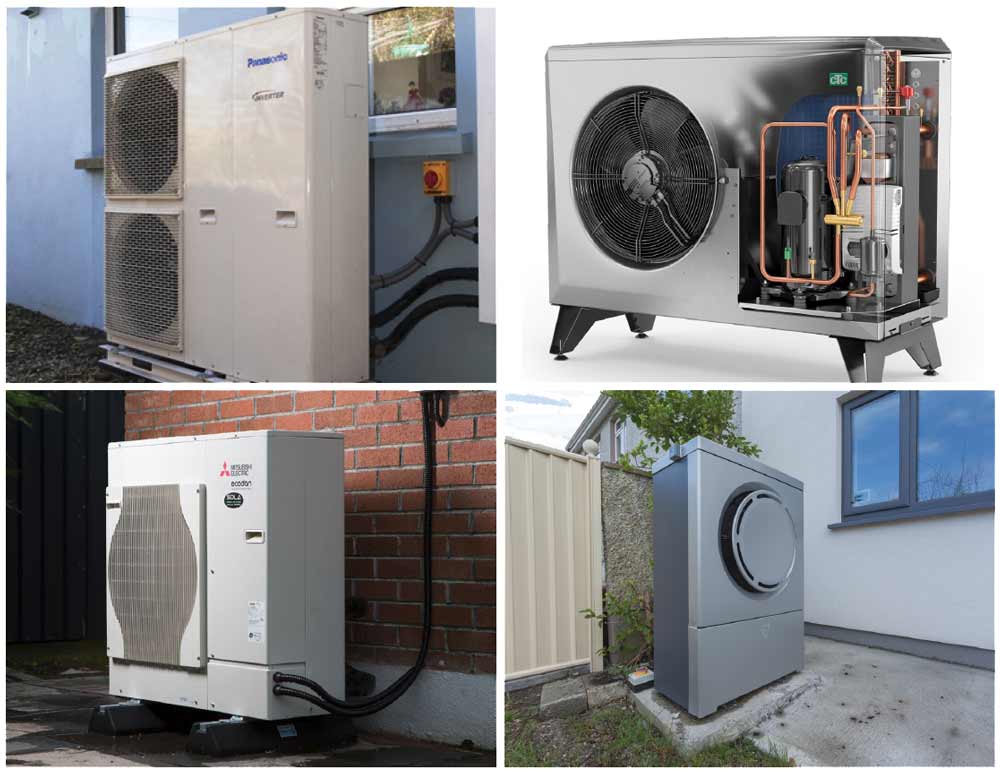
Outdoor units serve as the collector for air source heat pumps, including clockwise from above left, units from Mitsubishi Electric Ireland and Panasonic (installed as part of Tipperary Energy Agency’s SuperHomes retrofit scheme), CTC (an illustration showing the inner workings), and a Thermia unit outside Ireland’s first certified passive house retrofit, in Salthill, Co. Galway.
O’Donnell expands on this point: “The key question to ask in an existing building is how much the homeowners are spending on energy. When we have that information, we know how many kilowatts they’re using. If you ask how many litres of oil or kWh of gas you’re using, then we know how much energy the heat pump needs to provide.” O’Donnell said this information would prevent heat pumps being grossly undersized, but warned of the risk of comfort-taking – the phenomenon where building occupants take back the benefits of energy efficiency improvements by heating their home to higher temperatures – causing energy use to increase, given the low running cost. “Assuming a COP of 4 and a mix of night rate and day rate electricity, the cost is about 3.5c per kWh. If you’re going to fit anything to a house, the one thing that will pay for itself most quickly is a heat pump.”
Although the HPAI has some concerns about whether buildings which can’t be cost-effectively brought up to meet the necessary HLI target should be excluded from heat pump grants, the association acknowledged the benefits of having an independent technical advisor to help with the decision on insulation level required and heating system upgrade.
‘You don’t need to have a super-insulated building to have a heat pump instead of an oil or gas boiler, but it’s good that SEAI are taking a considered approach – that the homeowner gets an independent assessor to check it out before proceeding to the next step,” said O’Donnell. “So while putting a heat pump in to a draughty old building instead of an oil boiler will still save money, having a little bit of input to reduce the demand first is a good thing.’
While welcoming the grants, Brian Cooley emphasised that the HPAI was keen to continue to work with SEAI on additional proposals to fine tune the scheme and its workings.
“We have had a number of suggestions from our members which we feel could benefit the scheme as a whole,” he said. “We would like to see domestic hot water heat pumps supported. They would be a welcome addition in allowing apartments to participate in the scheme and in situations where the piping and wiring situation in a house doesn’t easily facilitate the installation of the hot water tank directly connected to the main heat pump. “In the case of a listed building where insulation measures are impossible but the assessor’s report shows that the installation of a heat pump would reduce the carbon emissions of the building by 40%, we ask that these buildings would also be allowed,” said Cooley. “A significant emission reduction should be rewarded.”
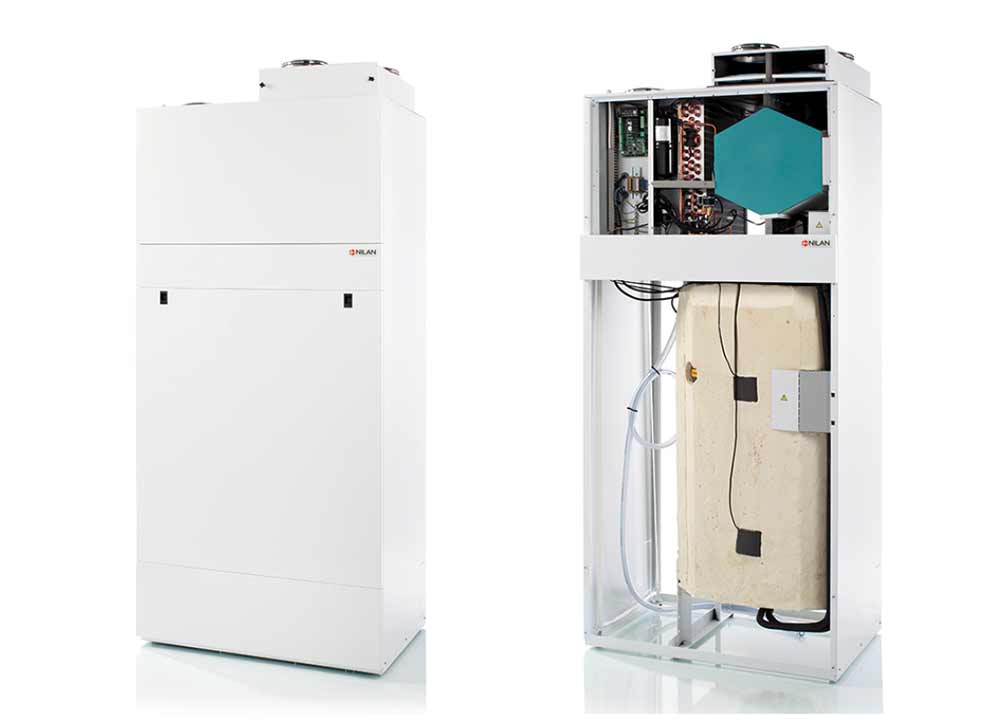
The inner workings of the Nilan Compact P exhaust air heat pump
SEAI have nonetheless made a significant change by opening up the grants to pre-2011 homes, compared to the pre 2006 cut-off point that previously applied under the Better Energy Homes scheme. In the region of 220,000 new homes were built between 2006-2008 alone, at a time when the peak and gradual collapse of the house-building boom led to the construction of homes which are likely to be extremely leaky, inaccurately insulated and non-compliant with minimum standards.
Energy consultant Mark Shirley of 2eva. ie welcomed the move. “I’m delighted that they’ve brought it out and moved the benchmark forward to 2011,” he said. “It’s capturing a huge number of homes that were built in the boom. I think that’s an acknowledgement of a realistic situation. Probably a significant majority of them would benefit from an energy upgrade now – albeit many of them are only ten years old.” Shirley said that homeowners considering heat pump grants should consider insulation work too, in spite of the fact that insulation measures aren’t available for homes built and occupied post 2005. “You would like to hope that if people are going to the trouble of a heat pump they’d give consideration to an insulation upgrade.”
One man who has a rare amount of experience in retrofitting heat pumps – and no commercial involvement in a heat pump company – is Tipperary Energy Agency CEO Paul Kenny, who has overseen the installation of scores of heat pumps into energy upgraded homes in the Tipperary region and beyond under the Superhomes scheme, along with other energy efficiency measures including airtightness, insulation upgrades and the installation of mechanical ventilation systems, combining cost-effective energy efficiency, comfort and indoor air quality.
As reported previously in Passive House Plus, 20 of the participating SuperHomes dwellings – 19 of which were fitted with Mitsubishi Ecodan air-to-water heat pumps – have been undergoing monitoring by students at LIT since March 2017. Indicative results are remarkably positive for retrofits: the average seasonal COPs for the 20 heat pumps are working out at roughly 3.2 – as an average for both space heating and hot water, including a heating season that took in the ‘Beast from the East’.
Kenny cautions that similar results can only be expected if real care is taken to ensure that the retrofits are properly designed to ensure that heat pumps can run at sufficiently low temperatures. “If the level of technical knowledge, engineering design and supervision in the installation and commissioning is not sufficiently resourced, we could end up with poor performance,” he warns, offering an example. “Two contractors. One prices to change radiators, the other doesn’t. In the case of the one who doesn’t, the heat pump will have to run at higher temperatures, at lower efficiencies, leading to lack of customer satisfaction. What we see at SuperHomes is a combination of comfort and a meter that tells the homeowner what they’re paying, leading to high satisfaction levels.”
Ultimately, time will tell as to whether these kind of results can be replicated nationally and at scale. But there are signs of a significant ratcheting up of policy ambition in the design of this scheme – and SEAI’s increasing efforts to stimulate profound energy savings from Ireland’s existing stock via the likes of the Deep Retrofit scheme – reflecting a recognition of the need to help Irish people to invest in high levels of energy efficiency and to replace climate-destroying fossil fuels with clean, cost-effective renewable energy sources. And – all of the usual caveats notwithstanding – that can only be a good thing.
About the Heat Pump Association of Ireland
The Heat Pump Association of Ireland is the industry representative body of manufacturers and importers of heat pumps in the Republic of Ireland. Membership is open to all manufacturers and importers and distributors of heat pumps, with the aim of giving the industry a single representative voice with other sectors of the construction industry, educators and legislators. It is a non-profit company established to promote the benefits of heat pumps.
The heat pump brands represented include the following: Alpha Innotec, De Dietrich & Robur (Origen Energy), Carrier & LG (DWG Refrigeration Wholesale), Ciat & Kronoterm (Glenergy), CTC & Viessman (Precision Heating), Daikin, Firebird Heating Solutions, Grant Engineering Ireland, Groupe Atlantic (Ideal), Heliotherm (Climate Control Renewables Ltd /Renewable Energy Centre), Hitachi, IVT Bosch (Energy Superstore), Mitsubishi Electric, Mitsubishi Heavy (Diamond Air), Nibe (Unipipe), Nilan, Panasonic, Thermia (Ashgrove Renewables), Toshiba (AC Heating/Baxi Potterton Myson/GT Phelan), Samsung (Joule), Water Furnace, Weider, Euronom & Argo (Alternative Heating & Cooling).


